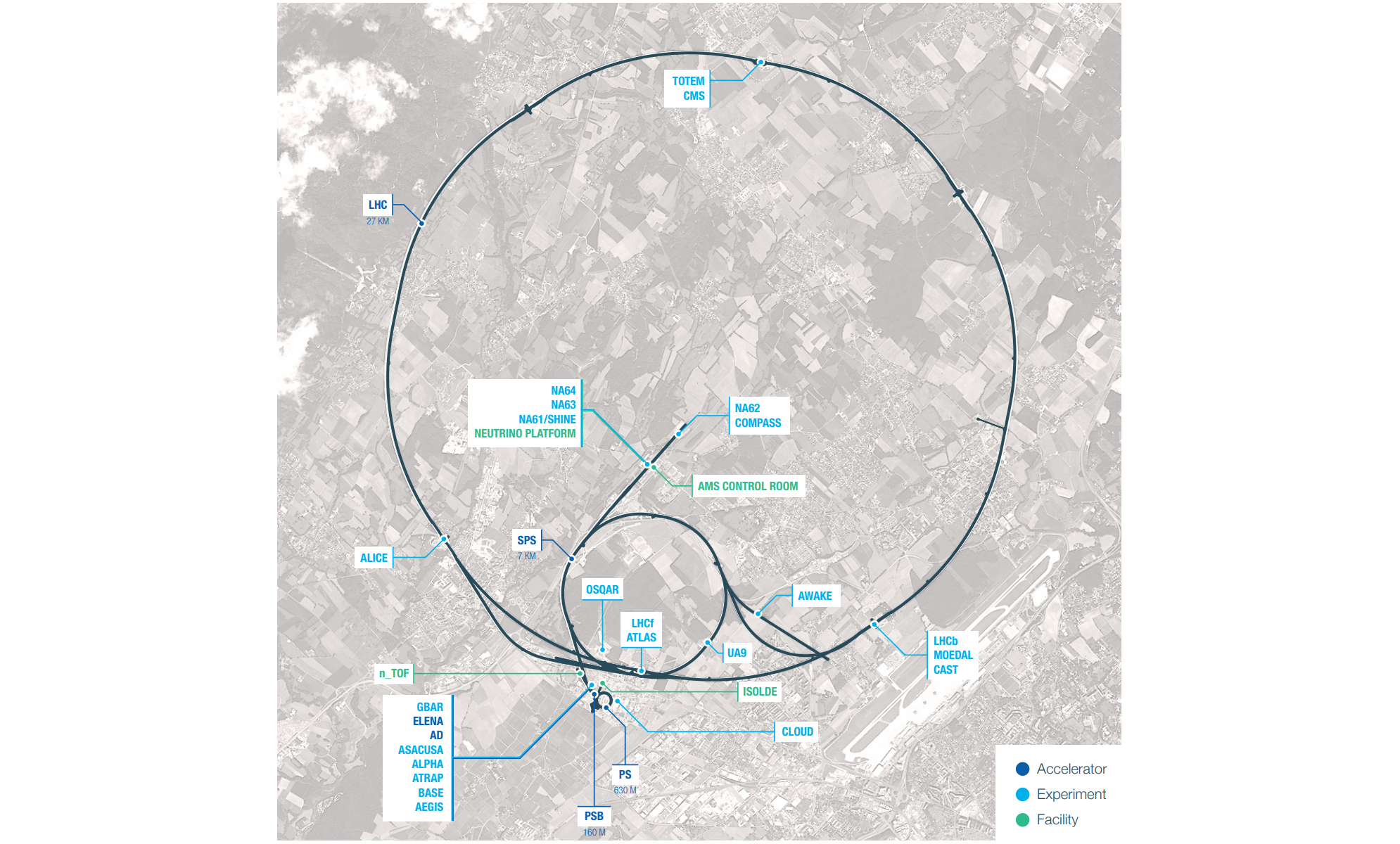CERN provides a unique range of particle accelerator facilities, enabling research at the forefront of human knowledge. In 2019 and 2020, CERN’s flagship accelerator, the Large Hadron Collider (LHC), was in its second long shutdown (LS2), and many of the Laboratory’s accelerator, detector and computing infrastructures underwent a period of consolidation and upgrades. Due to this shutdown, several environmental indicators show a different pattern from the previous reporting timeframe of 2017-2018. LS2 was an important step on the way to the high-luminosity phase of LHC running (HL-LHC), which is scheduled to begin in 2028 and will deliver 10 times more data than the LHC era. This will allow scientists to search for extremely rare phenomena and perform measurements with greater precision, increasing our understanding of the fundamental processes of the universe and unleashing new discovery potential.
CERN's accelerator complex

CERN’s unique complex of accelerators supplies a variety of experiments and facilities. CERN is home to a large range of experiments, covering a wealth of topics in physics ranging from studies of the fundamental constituents of matter to the search for particles that were only present in the very early universe. The flagship LHC is the world's largest and most powerful particle accelerator. It collides beams of protons or heavy ions, and the results of these collisions are recorded by several particle detectors.
Second long shutdown
After a first long shutdown during 2013 and 2014, followed by four years of operation (Run 2), CERN's accelerator complex entered its second long shutdown at the beginning of 2019. LS2 is a two-year maintenance, consolidation and upgrade programme during which the accelerators and detectors are not in operation. Even though the facilities are not running, physics research continues through the analysis of data gathered during earlier running. Services such as cooling and ventilation also continue through the long shutdowns, accounting for the continued, albeit much reduced, consumption of commodities such as energy and water.
During LS2, many projects preparing for Run 3 of the LHC and for the future HL-LHC phase were carried out. One main focus of the shutdown was the LHC Injectors Upgrade (LIU) project, which saw the entire accelerator chain upstream of the LHC refurbished to provide the more intense beams that the HL-LHC will need. Work on the LHC itself, and the remaining upgrades to the LHC experiments, will take place during the third long shutdown scheduled from 2025 to 2027.

Environmental management of excavation works
The new equipment for the HL-LHC required significant civil engineering works to be undertaken at the LHC’s Point 1 in Meyrin, Switzerland, and Point 5 in Cessy, France. An environmental engineer, under the responsibility of the contractor in charge of the project, followed the progress of the construction work, as required by CERN in the conditions for the award of the contract. Excavation works to create new underground caverns and tunnels were carried out at both sites, generating around 100 000 m3 of excavated material. This material was analysed to ascertain its quality, consequently determining whether it should be re-used or eliminated through appropriate pathways. On the Meyrin site, much of the excavated material will be re-used to create a platform for new buildings. On both sites, the topsoil will be re-used for landscaping.
CERN also required the contractor to draw up water management plans for the worksites to prevent pollution of surrounding watercourses, for instance the Nant d’Avril in Switzerland and the Oudar in France.
High-Luminosity LHC
The HL-LHC will be the culmination of the LHC project, running from 2028 to about 2040. To develop new components for the collider, CERN is pushing several technologies to their limits, notably in terms of superconductivity, computing and electronics. In the long term, these innovations could bring considerable benefit to society as a whole. An example of this is the innovative superconducting electrical transmission lines for the HL-LHC magnets (see In focus).
With the HL-LHC’s higher performance in terms of particle collisions and consequently discovery potential comes increased resource consumption. An optimisation plan has therefore been developed, with a commitment to limit the increase in energy consumption, as discussed in the energy chapter, which describes the energy efficiency of CERN’s accelerator complex. The use of cooling water is discussed in the water and effluents chapter.
In focus
Amalia Ballarino, designer and project leader for the new superconducting electrical transmission lines at CERN.

— What is this new transmission line?
AB: It is a direct-current superconducting electrical transmission system, which has been developed at CERN, based on magnesium diboride (MgB2) and high-temperature superconducting (HTS) ReBCO materials. It will connect the power converters to the magnets of the HL-LHC. Eight systems of two different types are needed for the HL-LHC. Each system is composed of up to 19 MgB2 superconducting cables inside a compact and flexible cryostat and is about 100 metres long. Superconductors conduct electricity with no resistance, allowing the transport of much higher current densities than ordinary cables without losses. With its 120 kA feeding several circuits at 25 K, the HL-LHC transmission system is the most powerful ever built and operated.
— Does this have any application outside CERN?
AB: Lines like these offer unrivalled solutions for high-power transmission. Huge electrical currents can be transported within cryostats with compact diameters. If you think about renewable energy sources, for instance, the production is often located far away from the point of consumption: future transmission grids will have to transfer high electric power over distances of hundreds of kilometres. Compact superconducting lines, with their high-capacity transmission and low losses, could become an enabling technology for an overall more sustainable transmission of electric energy.
Learn more
Questions regarding this report may be addressed to environment.report@cern.ch.
